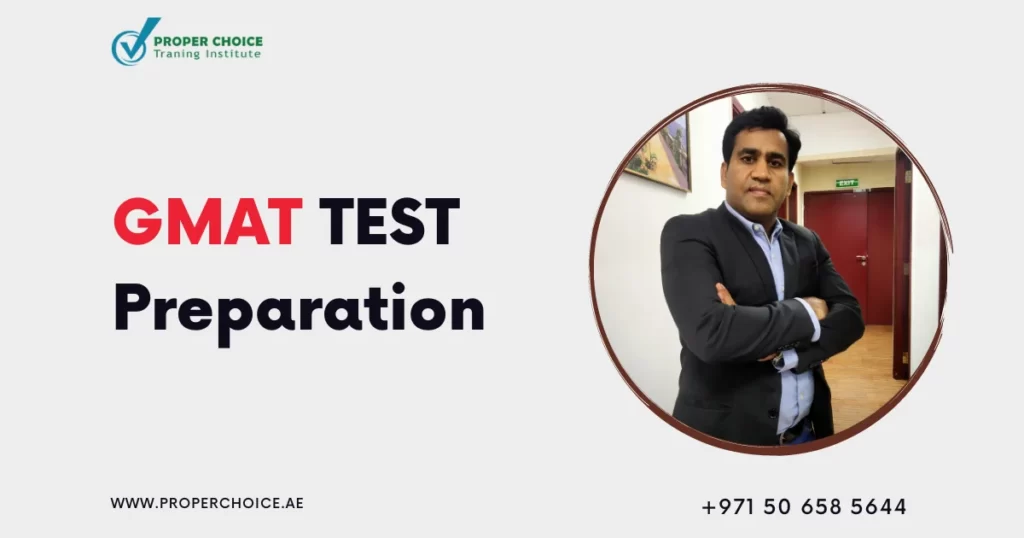
GMAT Overview
The Graduate Management Admission Test (GMAT) is one of the core criteria of most business schools when it comes to assessing who is eligible to be accepted into their prestigious postgraduate business programs. After all it is a matter of making the future of the potential candidate. Though you may think that it is basic math and English, the pattern of the exam and its method of assessment leaves even the best of students hard-pressed to attempt it without seeking aid; by considering this vital need, Proper Choice Training Institute offers the right guidance and comprehensive support for the GMAT Preparation in Dubai takers by not only teaching but also mentoring each student until his or her test date.
By keeping in mind, that each aspirant has a different level of subject knowledge; we have designed our course material in such a way that it clears the concept of every individual from the basic to the advanced levels. We wish to augment our students’ capabilities and skills as well as help them attain their splendid futures; thus we are here to facilitate all their needs.
Apart from exceptional in-class training, we provide a set of practice questions and a GMAT sample test that has been uniquely designed after years of experience which help an individual to attain the overall concept of the GMAT Test. Our Trainers are highly talented and have a great track record to help the students acquire the right spirit for the test.
GMAT Course Plan
- 45 hrs Training (15 classes, each class 2 hours)
- 5 Online ( Computer-based ) MOCK Tests and their reviews (Each test 3 hours, total 15 hours)
- Unlimited paper based practice tests to make conceptually strong
- Time Managing strategies, Tips/Tricks to Improve score
- Unlimited doubt clearing sessions
- Duration : Customized Schedule as per the convenience of student
- Days : Any day, as per availability of student and faculty
- 45 hrs Training (15 classes, each class 2 hours)
- 5 Online ( Computer-based ) MOCK Tests and their reviews (Each test 3 hours, total 15 hours)
- Unlimited paper based practice tests to make conceptually strong
- Time Managing strategies, Tips/Tricks to Improve score
- Unlimited doubt clearing sessions
- Duration : 10 Weeks
- Days : Friday and Saturday
GMAT Test Structure
The GMAT is a Computer-adaptive test, and all test takers get a different set of questions. The test is divided into four sections, Quantitative, Verbal, Analytical Writing Assessment (AWA), and Integrated Reasoning (IR).
Graduate Management Admission Council (GMAC) has changed the GMAT format with effect from 16th April 2018. The Quantitative Section of GMAT consists of 31 questions with a 62-minute time limit. The questions test your knowledge of and skills in Arithmetic, Elementary Algebra, basic Geometry, basic probability, and statistics. The quantitative section has two question types: Problem Solving and Data Analysis. Problem-solving questions are multiple-choice questions with five answer choice options, if your approach to solving the question is right, you will be ending up with one of the best answer choices among five options available. Data sufficiency is also multiple-choice questions with five answer choice options. These questions are unique to the GMAT as you are presented with a question followed by two statements containing additional information. Your task is to determine whether the data given are sufficient to answer the question posed.
The Verbal section of the GMAT consists of 36 multiple–choice questions with a 65-minute time limit. Three question types are presented in the verbal section: reading comprehension, sentence correction, and critical reasoning. The questions test your proficiency in reading and comprehending test-based materials, evaluating the strength and weaknesses of arguments, and applying your knowledge of standard written English to correct the errors. All questions have five answer choice options from which you must select the one best answer choice.
The total score of the GMAT is 800, made from a combination of the scaled scores of Quantitative and Verbal.
The Integrated Reasoning section of the GMAT is designed to analyze graphs of data, tables of data, etc., and the question will have one of the four formats: Table analysis, Graphics interpretation, Multi-source Reasoning, and Two-Part Analysis. This section includes 12 questions to be completed in 30-minute. You may sort data in a spreadsheet or make calculations with the help of an on-screen calculator. The section score is reported independently on a scale of 0-8 in 1 point increment based on a number of questions answered correctly. The candidate receives credit for questions with multiple parts only if all parts of the questions are answered correctly.
In the AWA Section, you will have 30-minutes to write a written analysis of a presented argument. You will type your response on a computer screen using a basic word processing program. This section is graded on a 0-6 scale in 0.5 increments.
You can take the GMAT test in three different orders followed by two short breaks in between
- Order 1 (Original): AWA, IR, Quantitative and Verbal
- Order 2: Verbal, Quantitative, IR and AWA
- Order 3: Quantitative, Verbal, IR, and AWA
Contact Details
Enquiry Form
Popular Courses
